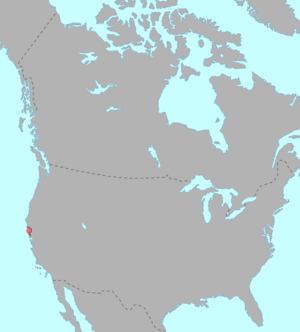Pomoan languages
| Pomoan | |
|---|---|
| Pomo | |
| Ethnicity: | Pomo people |
| Geographic distribution: | California |
| Linguistic classification: |
Hokan ?
|
| Glottolog: | pomo1273[1] |
|
Pre-contact distribution of Pomoan languages | |
The Pomoan, or Pomo /ˈpoʊmoʊ/,[2] languages are a small family of Native Californian languages spoken by the Pomo people who formerly occupied the valley of the Russian River and the Clear Lake basin. The Pomoan languages are severely endangered – with the exception of Kashaya, which had few dozen speakers in the 1990s, they are spoken by only a handful of elderly people. Northern Pomo and Northeastern Pomo are without known speakers and presumed to be extinct.
Geographical distribution
John Wesley Powell, who was the first to define the extent of the family, noted that its boundaries were the Pacific Ocean to the west, Wintuan territory in the Sacramento Valley to the east, the head of the Russian River to the north, and Bodega Head and present-day Santa Rosa to the south (Powell 1891:87-88). Only Northeastern Pomo was not contiguous with the other Pomoan languages, being separated by an intervening region of Wintuan speakers.
Internal relationships of languages

Pomoan is a family of seven languages. Their relationship to one another was first formally recognized by John Wesley Powell, who proposed that they be called the "Kulanapan Family" (Powell 1891). Like many of Powell's obscure nomenclatural proposals, particularly for California languages, "Kulanapan" was ignored. In its place, Pomo,[3] the term used by Indians and Whites alike for Northern Pomo was arbitrarily extended to include the rest of the family. It was thus as "Pomo" that all seven languages were first systematically identified by Samuel Barrett (1908). To avoid complications, Barrett named each of the Pomoan languages according to its geographic position ("Northern Pomo," "Southeastern Pomo," etc.). This naming convention quickly gained wide acceptance and is still in general use, except for the substitution of "Kashaya" for Barrett's "Southwestern Pomo". Regrettably, however, Barrett's geographical language names often lead those unfamiliar with the Pomoan languages to the misconception that they are dialects of a single "Pomo" language.
Various genetic subgroupings of the family have been proposed, although the general outlines have remained fairly consistent. The current consensus view (cf. Mithun 1999) favors the tree presented in Oswalt (1964), shown below. (Major branches are in bold and dialects of individual languages are in italics, subgroupings in small caps):

- Southeastern Pomo Lower Lake, Sulphur Bank
- Eastern Pomo: Upper Lake, Big Valley
- Northeastern Pomo
- Western Branch
- Northern Pomo: Potter Valley, Guidiville, Pinoleville
- Southern Group
- Central Pomo: Hopland = Shanel, Yokaya, Point Arena-Manchester
- Southern Pomo: West Creek, Salmonhole
- Kashaya = Kashia = Southwestern Pomo
Essentially identical versions of this classifications are presented in Oswalt and McLendon's "Introduction" to the Pomo chapters in Heizer, ed. (1978) and in Campbell (1997). The most important dissenter was Abraham M. Halpern, one of the few linguists since Barrett's time to collect comparative data on all of the Pomoan languages. Halpern's classification differed from Oswalt's mainly in the placement of Northeastern Pomo. Instead of considering it an independent branch of the family, Halpern grouped it with the languages of Oswalt's "Western" branch, suggesting the possibility that Northeastern Pomo represents a recent migration of a Northern Pomo subgroup (Halpern 1964; Golla 2011:106-7).
See also
- Boontling – a constructed dialect of English incorporating Pomo words
Notes
- ↑ Hammarström, Harald; Forkel, Robert; Haspelmath, Martin; Bank, Sebastian, eds. (2016). "Pomoan". Glottolog 2.7. Jena: Max Planck Institute for the Science of Human History.
- ↑ Laurie Bauer, 2007, The Linguistics Student’s Handbook, Edinburgh
- ↑ The etymology of the term "Pomo" is complex. It seems to be a combination of the Northern Pomo words [pʰoːmoː], "at red earth hole" and [pʰoʔmaʔ] (containing [pʰo-], "reside, live in a group"), together suggesting "those who live at red earth hole" (Campbell 1997:397, citing McLendon & Oswalt 1978:277)
References
- Barrett, Samuel A. (1908). The Ethno-Geography of the Pomo and Neighboring Indians. University of California Publications in American Archaeology and Ethnology, 6.
- Campbell, Lyle. (1997). American Indian languages: The historical linguistics of Native America. New York: Oxford University Press. ISBN 0-19-509427-1.
- Goddard, Ives (Ed.). (1996). Languages. Handbook of North American Indians (W. C. Sturtevant, General Ed.) (Vol. 17). Washington, D. C.: Smithsonian Institution. ISBN 0-16-048774-9.
- Golla, Victor. (2011). California Indian Languages. Berkeley: University of California Press. ISBN 978-0-520-26667-4.
- McLendon, Sally & Robert L. Oswalt (1978). "Pomo: Introduction". In California, ed. Robert F. Heizer. Vol. 8 of Handbook of North American Indians, ed. William C. Sturtevant, pp. 274–88. Washington, D.C.: Smithsonian Institution. ISBN 978-0-16-004574-5.
- Mithun, Marianne. (1999). The languages of Native North America. Cambridge: Cambridge University Press. ISBN 0-521-23228-7 (hbk); ISBN 0-521-29875-X.
- Powell, John Wesley. (1891). Indian Linguistic Families Of America, North Of Mexico. Annual Report of the Bureau of American Ethnology 7:1-142. Washington, DC: Government Printing Office.
- Chestnut, Victor King (1902). Plants used by the Indians of Mendocino County, California. Government Printing Office. Retrieved 24 August 2012.
External links
- Pomo (Yakaya, Yokaia, Shanel, Kábinapek) (Native Languages of the Americas)
- Kashaya (Kashia, Southwestern Pomo) (Native Languages of the Americas)
- Pomo/Kashaya Bibliography
- Pomo People: Brief History
- "New wellness center hosts first Pomo language workshop". Lake County News Reports. 2012-04-15. Retrieved 2012-08-08.
